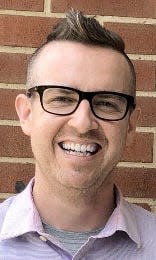Voices of Faith: Beliefs should be at center of healing

An elder of the church once told me of a visit he had with an older man who was a fellow member of the congregation and a beloved friend.
The older man was dying of cancer and after several rounds of treatment, there was nothing more that the doctors could do. He was living at home for his remaining days and so this elder went to visit.
After a time of conversation and storytelling, the elder asked the older man if he’d like to pray, to which he agreed. The elder began the prayer with, “God, please bring your healing to…” and the older man interrupted. “Friend,” he said, “that’s not how this prayer goes.”
A tear welled in the corner of the elder’s eye. He nodded and they both bowed their heads again. The elder started again, “God, please grace my friend with comfort and peace in his final days, and may he know he is loved always.” They both responded, “amen.”
The way that we are seen is not always the way in which we see ourselves.
One perceives something to be healed and one perceives the same to be accepted. One of the qualities of a loving relationship and a loving community is ensuring that any person has the ability to be heard and seen – and that each of us has some agency in determining how we wish to be heard and seen.
Without this agency and without honoring this agency in another, relationships soon become patronizing and even controlling. The elder’s mistake was innocent enough. He wanted his friend to be made well; he wanted more time together; he was not prepared to suffer this loss. When his friend spoke, the elder listened. There can be far more harmful outcomes when we refuse to see and listen.
There are many stories of Jesus healing within the gospels of scripture. One of the most common ways that a healing story will begin is with the voice of one calling out to Jesus as he was passing by. Jesus would then approach the one who called out, and although the gospel author would include details of the identity of the one who called – they were possessed, lame, wounded, etc. – Jesus would respond by asking, “What do you want me to do for you?”
This is like saying, “I may see you one way, but tell me how you see yourself and wish to be seen by me.” To see and be seen; to hear and to be heard.
It is good and beautiful that we are so often wanting to help and to see all made well. It is also good and beautiful to move about the world and notice all of the distinction and difference and to do so without judgment and valuation - without view of difference as presumption of need. There is a temptation to pray or act (or legislate) for the “healing” of another or of the entire world, and for our image of healing to be nothing more than assimilation - a healing in our image without consent.
Reconciliation and healing occur, it seems, when one introduces themselves and the community welcomes and receives them. Healing occurs when one asks for help and another responds with what has been requested. And it seems that some things can be made well when nothing more is offered than listening, gratitude, and acceptance.
Rev. Chris McCreight is minister at Hiram Christian Church and chaplain of Hiram College.
This article originally appeared on The Repository: Voices of Faith: Beliefs should be at center of healing
